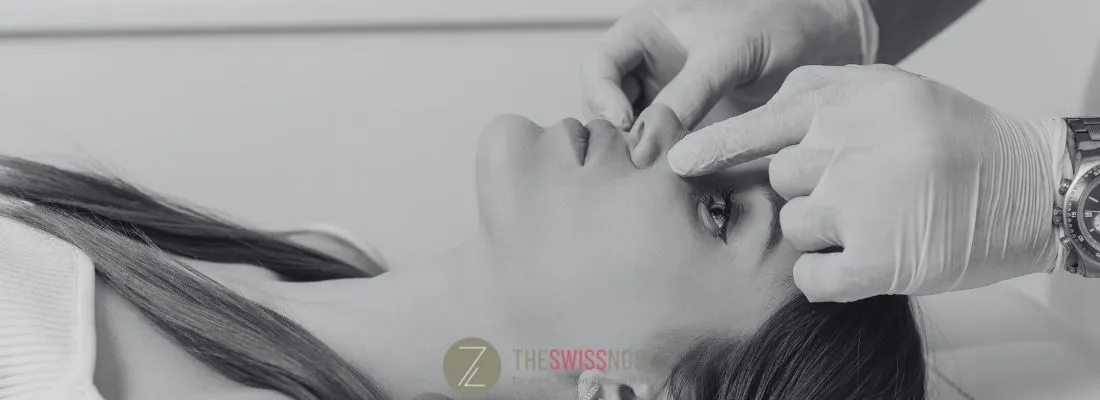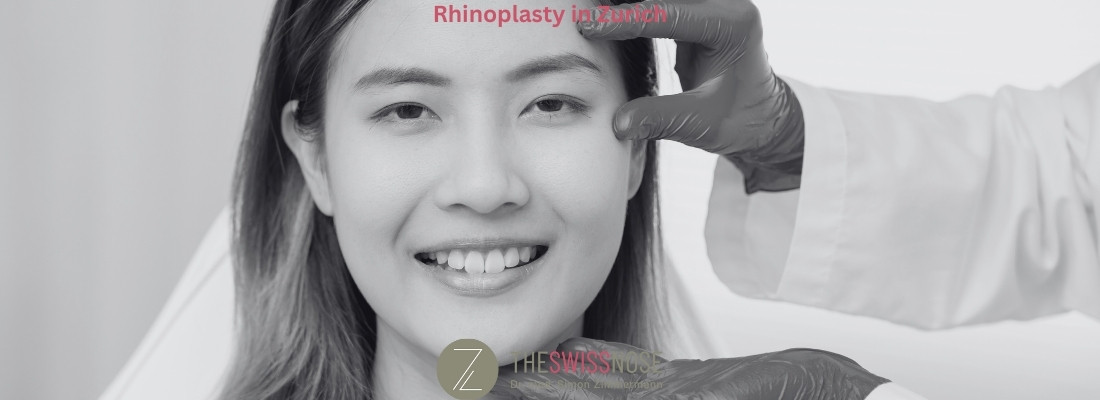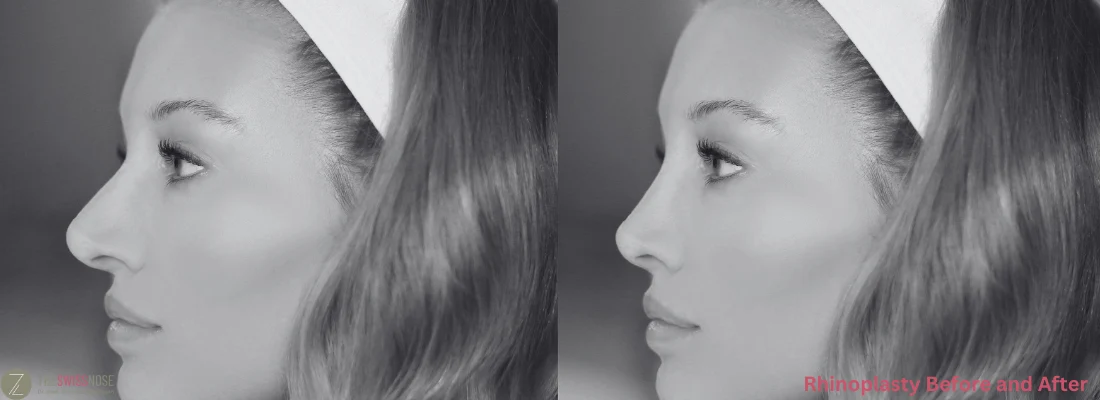Rhinoplasty Costs | Nose Job Surgery Zurich | theswissnose
We are here to help you in Rhinoplasty. A more beautiful version of your present nose.

What is rhinoplasty?
Rhinoplasty is surgical operation to reshape and change how the nose looks, usually for cosmetic reasons but occasionally for functional ones as well, such enhancing breathing. There are many types of cosmetic surgery for rhinoplasy such as augmentation rhinoplasty, tip rhinoplasty, rhinoplasty bridge reduction, laser rhinoplasty, revision rhinoplasty, nonsurgical rhinoplasty, filler rhinoplasty, injectable rhinoplasty, rhinoseptoplasty, reduction rhinoplasty, liquid nose job. Rhinoplasty is commonly performed as an outpatient operation under general anesthesia, can improve face harmony and self-confidence. Although rhinoplasty recovery time vary, patients may endure swelling and bruising for a few weeks after the operation.
What is nose job?
Nose job is more commonly and casually used than the formal medical term "rhinoplasty" by healthcare professionals to describe the nose surgery. A "nose job" or "rhinoplasty" both involve the same surgical procedure. The procedure of changing the nose's size, shape, or appearance for either cosmetic or practical purposes is described by both names. Non surgical nose job is another term.
Rhinoplasty in Zurich
Patients choose rhinoplasty in Zurich for various reasons, including:
- Exceptional surgeons: Zurich is renowned for having top-tier plastic surgeons with in-depth knowledge of rhinoplasty treatments.
- Modern medical facilities and fully-stocked clinics are available in the city, allowing for safe and efficient surgeries.
- Reputation for excellence : Zurich has a good track record of upholding strict safety regulations and medical care standards.
- Access to advanced techniques: Patients seek rhinoplasty Zurich for access to the latest surgical techniques and technology in the field of rhinoplasty.
- Privacy and discretion: Switzerland's strict privacy laws ensure patient confidentiality and discretion during the entire surgical process.
- Tourism opportunities : Zurich's cultural attractions and beautiful surroundings provide an appealing backdrop for patients traveling for rhinoplasty.
- International accessibility: Zurich's well-connected airport and transportation options make it easily accessible for patients from around the world.
- Multilingual staff: Many medical professionals in Zurich speak multiple languages, making it convenient for international patients.
Who is a good candidate for rhinoplasty?
A good candidate for rhinoplasty typically exhibits the following characteristics:
- Physical maturity: Ideal candidates have completed their facial growth, typically around the age of 15-17 for girls and 17-18 for boys.
- Cosmetic concerns : Individuals with specific aesthetic concerns about the appearance of their nose, such as humps, asymmetry, or size, are suitable candidates for cosmetic rhinoplasty
- Functional issues: Those experiencing breathing difficulties due to structural problems like a deviated septum may benefit from rhinoplasty.
- Realistic expectations : Patients should have realistic expectations about the potential results of the nose plastic surgery and understand its limitations.
- Good general health: In order to endure nose job surgery and the healing period, candidates should be in good physical and mental condition.
- Non-smoker: Smokers are frequently encouraged to give up smoking before and after surgery because it can slow closed rhinoplasty recovery. and raise the chance of problems.
- Weight stability is crucial since severe weight swings can harm the outcomes of rhinoplasty.
- Commitment to post- operative care: Following the surgeon's instructions for post-operative care and recovery is essential for successful results.
- Consultation with a qualified rhinoplasty surgeon: A consultation with a board- certified plastic surgeon is crucial to determine if rhinoplasty is the right option and to discuss individual candidacy.
- Reputation for natural nose job for more natural outcomes : Rhinoplasty surgeons in Zurich are renowned for their capacity to produce results that seem natural.

How you prepare
- Consultation: Schedule a consultation with a surgeon.
- Medical evaluation: Ensure you're in good health.
- Stop smoking: Quit several weeks before surgery.
- Medication review: Share your medications with the surgeon.
- Avoid blood thinners: Stop medications like aspirin.
- Arrange transportation: Have a ride to and from the surgery center.
- Post-operativecare: Arrange for assistance during recovery.
- Prepare your home: Set up a comfortable recovery area.
- Follow instructions: Adhere to pre-operative guidelines.
- Confirm details: Verify surgery date, time, and location.
- Emotional readiness: Mentally prepare for the procedure.
- Time offwork: Plan for sufficient recovery time.
What are the steps of a rhinoplasty procedure?
The steps of a rhinoplasty procedure typically include:
- Anesthesia: Administer general or local anesthesia to ensure patient comfort and pain control during the surgery.
- Incisions: Make incisions inside the nostrils (closed rhinoplasty, nostril surgery) or across the columella (open rhinoplasty stitches) to access the nasal structures. Closed rhinoplasty incisions are hidden in nose.
- Nose reshaping: To get the desired appearance, sculpt and reshape the nasal bones and cartilage as necessary via nose. Rhinoplasty cartilage removal is commonly done during the procedure.
- Reduction or augmentation: To attain the desired shape and size, extra bone or cartilage is removed (reduction), or grafts or implants are added (augmentation).
- Tip modification: Refine and reshape the nasal tip to achieve symmetry and balance.
- Sutures and incision closure: Close incisions with dissolvable or removable sutures and place a splint on the nose for support.
- Dressing and bandaging: Apply a nasal cast and nasal packing (if necessary) to protect and stabilize the nose reshaping surgery
- Recovery and monitoring: Move the patient to a recovery area, where vital signs are monitored as they wake up from anesthesia.
- Post-operative care: Provide instructions for post-operative care and medication to manage pain and prevent infection.
- Follow-up appointments: Schedule follow-up visits to monitor healing and remove sutures and the nasal splint.
- Each rhinoplasty procedure is tailored to the patient's specific needs and goals, so the exact steps may vary.
What are the advantages of rhinoplasty?
- Enhanced self-confidence via nose reconstruction
- Nose correction of nasal deformities.
- Better nasal function and breathing.
- Improved aesthetic nose
- Correction of birth defects or injuries.
- Reversal of aging-related nasal changes in the context of nasal rejuvenation surgery.
- Correction of nasal airway obstruction
- Increased harmony in facial proportions.
- Potential relief from sinus issues.
- Enhanced overall facial balance.
- Customized results to meet individual goals.
What rhinoplasty can treat
Rhinoplasty can treat various nasal issues, including:
- Nasal humps or bumps are repaired via nose reconstruction surgery
- Crooked or asymmetrical noses.
- Wide or flared nostrils. (For nostril reduction)
- Large or misshapen nasal tips.
- Narrow or overly wide bridges.
- Breathing difficulties due to structural issues.
- Birth defects or congenital deformities.
- Injury-related nasal deformities.
- Age-related changes in nasal appearance.
- Correcting previous unsatisfactory rhinoplasty results.
Why it's done
Rhinoplasty is done for various reasons, including:
- Cosmetic enhancement: To improve the appearance of the nose for aesthetic reasons.
- Correcting of nasal asymmetry: Addressing imbalances in the nose's shape or size.
- Nasal hump reduction: Removing bumps or humps on the nasal bridge.
- Refining the nasal tip: Nose reshaping and enhancing the tip of the nose.
- Correcting of impaired breathing
- Correcting deviated septum (Septum rhinoplasty): Improving nasal function and breathing.
- Repairing nasal injuries: Fixing damage from accidents or trauma.
- Correcting congenital issues: Addressing birth defects or structural abnormalities.
- Reversing aging changes: Restoring a more youthful nasal appearance.
- Enhancing overall facial harmony: Balancing the nose with other facial features.
- Correcting previous surgical rhinoplasty results: Adjusting unsatisfactory outcomes from prior surgeries.
Risks
The risks associated with rhinoplasty include:
- Infection:The surgical site can become infected, requiring treatment with antibiotics.
- Bleeding: Excessive bleeding during or after this plastic surgery may necessitate additional procedures.
- Swelling and bruising: Common side effects, but they can be prolonged or severe in some cases.
- Scarring: Visible or internal scarring may occur, affecting the final results.
- Anesthesia complications: Adverse reactions to anesthesia can happen, though rare.
- Skin problems: Skin irregularities or persistent redness may develop.
- Breathing difficulties: In some cases, post-operative breathing problems can persist.
- Altered sensation: Temporary or permanent loss of sensation in the nasal area.
- Nasal asymmetry: Irregularities or imbalances in the final appearance of the nose.
- Dissatisfaction with results: The desired outcome may not be achieved, necessitating revision rhinoplasty.
- Septal perforation: A hole in the nasal septum can occur, leading to breathing issues.
- Need for revision surgery: Additional surgeries may be needed to address unsatisfactory results or complications.
- A piggy nose after rhinoplasty refers to a complication where the tip of the nose is over-rotated or upturned, resembling a pig's snout.
What you can expect
Here are itemized lists and answers to what should I expect during my rhinoplasty recovery?
During the Procedure:
- Anesthesia: You'll receive anesthesia to prevent pain and keep you comfortable.
- Surgical Actions: The surgeon will perform the necessary medical procedures.
- Monitoring: Vital signs will be monitored to ensure your safety.
- Limited Awareness: You may be semi-conscious but not feel pain.
- Surgical Team: A team of healthcare professionals will be present.
- Equipment: Surgical tools and equipment will be used.
- Sterile Environment: The room will be sterile to prevent infection.
- Communication: Limited communication due to anesthesia.
- Possible Imaging: Imaging may be used as needed.
- Addressing Issues: Any unexpected problems will be handled.
After the Procedure:
- Recovery Area: You'll be moved to a recovery area.
- Vital Signs: Continued monitoring for stability.
- Pain Management: Medication for pain relief will be provided.
- Wound Care: Dressings and care for surgical sites.
- Recovery Room: Transition to a recovery room.
- Ongoing Monitoring: Observations for your well-being.
- Medication: Prescribed medications as necessary.
- Post-op Instructions: Guidance on activities, diet, and wound care.
- Discharge Assessment: Evaluation to determine readiness for discharge.
- Follow-up Care: Information on post-operative appointments and care.
What questions should I ask my plastic surgeon about rhinoplasty?
Surgical Approach:
- Can you explain the expected results with this approach?
Risks and Complications:
How do you handle complications if they arise? (Know the surgeon's approach.)
Recovery:
What is the typical recovery time for rhino surgery? (Plan for post-surgery downtime.)
What should I expect during the immediate post-operative period? (Understand the recovery process.)
Scarring:
Will there be visible scarring, and if so, where? (Learn about potential scars.)
How do you minimize scarring? (Discuss scar management techniques.)
Nose job cost and Payment:
What is the total rhinoplasty cost of the procedure, including all fees? (Clarify the financial aspects.)
Do you offer financing options or payment plans? (Explore payment options.)
Surgical Facility:
Where will the nose operation take place? (Confirm the location.)
Is the facility accredited and equipped for rhinoplasty surgery? (Ensure safety and quality.)
Anesthesia:
What type of anesthesia will be used during the surgery? (Discuss anesthesia options.)
Who will administer and monitor the anesthesia? (Ensure qualified personnel.)
Before and After Photos:
Can I see before and after photos of patients with similar nasal issues? (Evaluate the surgeon's work.)
What can I realistically expect in terms of results? (Set realistic expectations.)
Recovery Instructions:
What post-operative care instructions should I follow? (Understand aftercare.)
Are there any restrictions on activities, diet, or medication? (Know post-surgery limitations.)
Follow-up Appointments:
How many follow-up appointments will be necessary, and when will they occur? (Plan for post-op visits.)
How will you assess my healing progress? (Discuss monitoring.)
Alternative Options:
Are there non-surgical alternatives or less invasive procedures to address my concerns? (Explore alternatives.)
Personalized Plan:
Can you outline a personalized treatment plan for my specific goals and needs? (Customize your approach.)
References:
Can you provide references from previous rhinoplasty patients I can contact? (Seek patient feedback.)
Realistic Expectations:
What are the realistic expectations I should have regarding the outcome of my rhinoplasty procedure? (Set appropriate expectations.)
Rhinoplasty Before & After Photos
Importance:
- Communication: Visual representations help patients and surgeons communicate effectively about desired outcomes.
- Expectation Management: They set clear and realistic expectations for the surgical results.
- Customization: Photos assist rhinoplasty doctors in tailoring procedures to meet individual patient goals.
- Documentation: They serve as documentation of the patient's consent and surgical plan.
- Evaluation: Patients can assess the surgeon's skills and past work to make informed decisions.
- Tracking Progress: Photos track post-surgery progress and rhinoplasty healing.

Benefits:
- Informed Decisions: Patients can make informed decisions based on visual evidence.
- Enhanced Satisfaction: Realistic expectations lead to higher patient satisfaction with the results.
- Educational Tools: Surgeons can use them as educational tools during consultations.
- Boost Confidence: Successful transformations increase patient confidence in the procedure.
- Comparative Analysis: Patients can research and compare surgeons' work to find the right fit.
- Legal Compliance: They may be required to meet legal and ethical standards in healthcare.
- Documentation for Records: Photos become part of the patient's medical record for long-term follow-up.
- Feedback and Referrals: Satisfied patients sharing photos can serve as referrals and provide valuable feedback.
- Quality Assurance: They contribute to maintaining high standards of surgical quality and ethics.
|
Glance to rhinoplasty |
|
|
How many days after rhinoplasty can you work |
Generally at least one week off from work to rest and recover is enough (During the first week after rhinoplasty, most patients experience the most significant swelling and bruising. You are likely to have a nasal splint or cast in place during this time) |
|
No, it is not painful to get a nose job. However pain and discomfort are common after getting a nose job |
|
|
How long after rhinoplasty can I fly? |
Surgeons often recommend waiting at least 7 to 10 days or longer before flying, as this allows the initial swelling and bruising to subside and the nasal tissues to stabilize. If you are planning a long-distance flight, it may be advisable to wait a bit longer, possibly 2 to 4 weeks post-surgery, to ensure that you are well into the healing process and less susceptible to complications. |
|
No, it is not considered 100% safe. Like any surgical procedure, carries some degree of risk, However, it is generally considered a safe and well-tolerated surgery when performed by a qualified and experienced surgeon in an accredited medical facility. |
|
|
Duration of treatment? |
The surgery typically takes between 1 to 3 hours. |
|
Suitable age range? |
Surgeons generally recommend waiting until nasal growth is complete, which typically occurs around the age of 15 to 16 for girls and around 17 to 18 for boys. |
|
Warranty or guarantee? |
Please ask your insurance service |
|
Can a nose job look natural? |
Yes, a nose job can look natural. In fact, many individuals seek rhinoplasty to enhance their nasal appearance while maintaining a natural and harmonious look that complements their facial features. |
|
Is nose job worth it? |
Yes, nose job is worth it. |
|
Some advices |
If you are looking for rhinoplasty near me (non surgical nose job near me) and want to learn our nose surgery price please contact us. Nose job price in Zurich, Switzerland, can range from CHF 8,000 to CHF 20,000 or more, depending on various factors including the surgeon's expertise and the specific requirements of the procedure. A revision rhinoplasty specialist is crucial because they possess the specialized skills and experience required to correct and improve the results of previous nose surgeries, ensuring both aesthetic and functional success. So you must find good surgeon. Showering after rhinoplasty should be done carefully, following your surgeon's instructions to avoid getting the surgical site wet and potentially causing complications. Breathing after rhinoplasty may initially feel congested and restricted due to swelling and nasal packing, but should gradually improve as the healing process progresses. |
